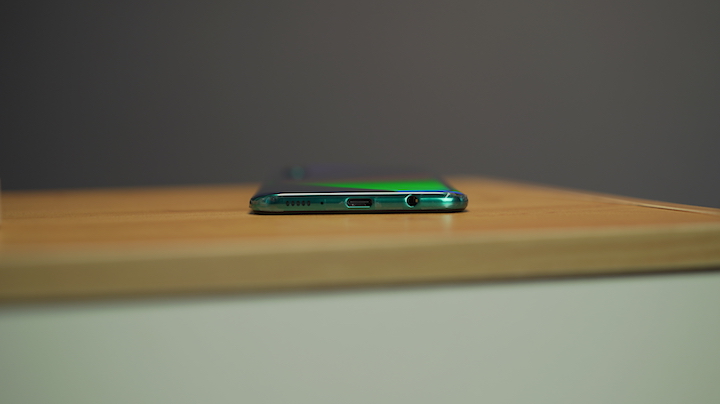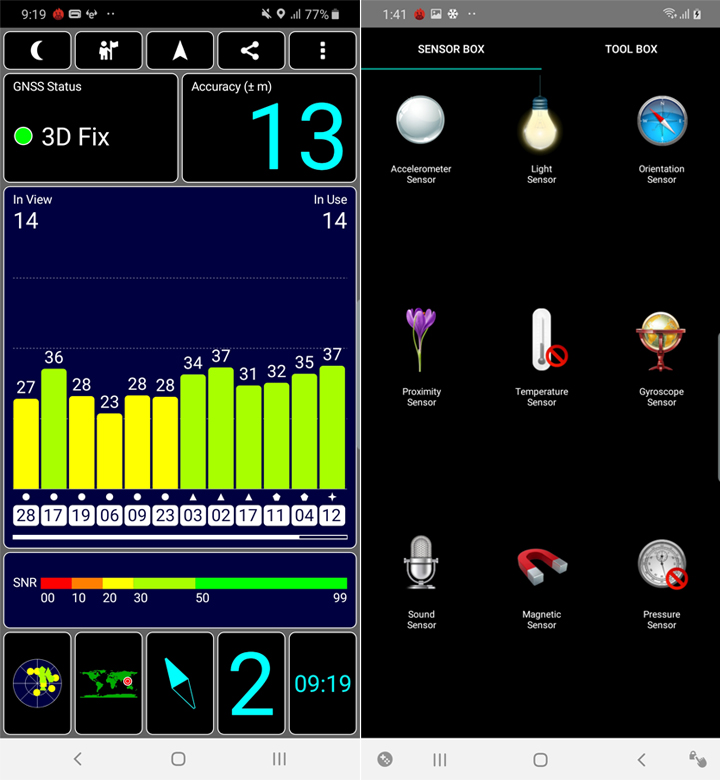Recently, Samsung launched the Galaxy A50s, a successor to their Galaxy A50. While it retains several aspects from the original, the A50s arrives with a newer chipset, enhanced cameras, and an improved design. Is it a decent improvement from the A50? Find out in our review.
Table of Contents

The design of the A50s doesn’t stray too far from its original version. It retains the glasstic rear construction, the triple camera setup on the upper corner of the rear, and the drop notch upfront housing the front snapper. Design-wise, it retains the rainbow-like reflection on the glasstic material, but also, the A50s now has a diamond pattern on the rear. Samsung’s update on this device’s aesthetics is well-appreciated.

As mentioned, the display has a drop notch where the front camera resides. Surrounding the panel are slim bezels, similar to the original A50.

On the right, we have the power button and volume rocker. Individuals with small hands might find it difficult to press them as the button placements are rather high. They are clicky, though.

The left side houses the dual SIM tray card and a dedicated micro SD card slot.

Up top, one can find the noise-canceling microphone.

A 3.5mm audio jack, USB-C port, a microphone, and a single downward-firing speaker can be found at the bottom of the device.

Despite having almost the same aspects as its predecessor, the A50s is a tad thinner than the A50. It’s also more comfortable to grip in the hands, and thanks to its updated aesthetics, it does look more premium and sleek.
The A50s comes with an FHD+ Super AMOLED Infinity U display measuring at 6.4-inches. Samsung didn’t specify if the A50s’ panel has protection, but it’s quite safe to assume that it’s also equipped with Corning Gorilla Glass 3, similar to the A50. Although they’re pretty similar, the A50s trumps the original device by having a Vivid profile in the Screen Mode option in the settings. Just as the name says, the colors are more accurate and punchier when compared to the A50’s panel.

Sound-wise, the downward-firing speaker supplied in the device delivers average audio quality that misses the highs and lows. It’s recommended to use your earphones instead.
Out of the box, the A50s runs on Android 9 Pie with Samsung’s One UI skin on top of it. The One UI installed in the A50s is the more updated version than that of the A50’s, as the former runs on the same UI that can be found in Samsung’s Note 10 series. Apps can be arranged in two ways, either all on the home screen or in a drawer mode. The A50s also allows users to choose between a system-wide light or night mode. Users also have the choice to use buttons or gestures to navigate around the handset.

The device comes pre-installed with the usual Google apps and has Microsoft apps as well. As for Samsung apps, the device has the Galaxy Store, Samsung Notes, Game Launcher, Samsung Max, Samsung Health, Galaxy Wearable, Bixby, and SmartThings. There are also third-party apps pre-installed, namely Netflix, Facebook, Spotify, and Lazada.
The A50s only has one storage offering at 128GB, with about 122GB of it usable. Storage is expandable up to 512GB via the dedicated micro SD card slot.
When it comes to biometrics, the A50s offers face and in-display fingerprint recognition. They’re both accurate and have a quick unlock response, which is an improvement from the original A50.
Samsung upgraded the cameras of the A50s, giving it a triple-rear setup consisting of 48MP primary + 8MP ultra-wide + 5MP depth shooters, while a 32MP snapper now sits at the front. It’s a step up from the A50’s 25MP + 5MP + 8MP triple camera setup and 25MP front camera.

The 32MP selfie shooter takes impressive shots in conditions with sufficient lighting. Details are sharp, and the colors are vibrant. For portrait selfies, the subject-background separation is excellent as well. However, it tends to soften up the details if the user doesn’t fix the focus on the subject. Still, images produced by the front camera are great enough to use on social media.
With the 48MP primary camera, the images produced had slightly overexposed highlights, but it could be remedied by tapping to focus and lowering the exposure level. There’s also Samsung’s usual post-processing, but it doesn’t look too artificial and is pretty good enough to post on social media. Pictures captured in right lighting conditions show good detail, but the story changes upon using its night mode. It works, but it’s not too good as the images produced were grainy and washed-out in slightly lit night shots. Portrait-wise, subject-background separation is modest, and details of the subject in focus are sharp.
For video, the A50s can shoot up to 4K at 30 fps and has slow-mo and super slow-mo features. They’re not that impressive but are modest enough under the right lighting conditions. A neat feature of the A50s is that it can also record video using the ultra-wide-angle lens. Additionally, the A50s has an AR feature in the Video mode of the camera. It’s fun to use and see your doodles come to life on someone’s face or your surroundings.
A step up from the Exynos 9610 equipped on the A50, the A50s runs on the Exynos 9611. Paired with the chipset are two RAM options, namely 4GB and 6GB, with our unit here possessing the latter. As always, we ran the device through our usual benchmarks. We’ve put them side-by-side with the A50’s benchmarks, to see how the two devices compare. Take a look:
| Benchmarks | Galaxy A50s | Galaxy A50 |
|---|---|---|
| AnTuTu | 150,949 | 136,262 |
| Geekbench | 349 (Single-Core) 1,255 (Multi-Core) | 1,709 (Single-Core) 5,671 (Multi-Core) |
| PC Mark | 5,819 (Work 2.0) | 5,675 (Work 2.0) |
| 3D Mark | 1,399 (SSE – OpenGL ES 3.1) 1,479 (SSE – Vulkan) | 1,277 (SSE – OpenGL ES 3.1) 1,395 (SSE – Vulkan) |
| AndroBench | 489.64 MB/s (Read) 185.27 MB/s (Write) | 496.52 MB/s (Read) 193.51 MB/s (Write) |
Most of the benchmarks on the A50s have increased in number compared to the A50, except for Geekbench and Androbench. Strange enough, despite the newer Exynos 9611, the A50s yielded lower numbers than that of the A50. With the Androbench scores, it also shows that the A50s has slower read and write speeds compared to the A50.

Even with the mixed benchmark results, executing tasks on the A50s was pretty smooth. The device handled navigation, social media browsing, and multitasking without any issues. Graphics-heavy games such as PUBG and Asphalt 9 also ran fine, although we did experience frame drops from time to time.

The usual connectivity options such as 4G LTE, Wi-Fi, Bluetooth, and the like, can be found on the A50s. Location-based services such as Google Maps, Grab, and such were not a hassle to use as well. The smartphone has a gyroscope sensor, making it possible to use AR apps on this one. One different thing from its predecessor, though is that the A50s has NFC support.

Similar to the A50, the A50s has a battery capacity of 4,000mAh with 15W fast charging support. Through the PC Mark battery test, the device scored 9 hours and 40 minutes. With our video loop test, the A50s yielded about 13 hours and 14 minutes of runtime. The results were pretty average, and it left us with about 20% at the end of the day.

Overall, the A50s is solid mid-ranger with a bright display, modest battery life, the latest One UI, and better camera hardware. The chipset benchmarks gave us mixed results, and there were a couple of frame drops during gaming, but apart from that, we think it’s a decent upgrade from the A50. Samsung has the A50s priced at PHP 18,990USD 324INR 27,433EUR 308CNY 2,357, which is just a couple of thousand pesos more than its predecessor.
Samsung Galaxy A50 specs:
6.4-inch FHD+ 19.5:9 sAMOLED Infinity-U display @ 1080 x 2340 px, 403ppi
Corning Gorilla Glass 3
Samsung Exynos 9611
Mali-G72 MP3 GPU
4GB, 6GB RAM
128GB internal storage
Expandable up to 512GB via dedicated microSD card slot
48MP(F2.0) / 8MP(F2.2) / 5MP(F2.2) triple rear cameras with LED Flash
32MP (F2.0) front camera
4G LTE
Single SIM, Dual SIM (nano)
WiFi
Bluetooth
GPS, A-GPS, GLONASS
In-display Fingerprint scanner
USB 2.0 Type-C
Samsung One UI (Android 9 Pie)
4000mAh Li-Po battery
15W Fast Charging
158.5 x 74.7 x 7.7 mm
Prism Crush Black, Prism Crush Violet, Prism Crush White
What we liked:
What we didn’t:
With additional input from Miguel Ty.

YugaTech.com is the largest and longest-running technology site in the Philippines. Originally established in October 2002, the site was transformed into a full-fledged technology platform in 2005.
How to transfer, withdraw money from PayPal to GCash
Prices of Starlink satellite in the Philippines
Install Google GBox to Huawei smartphones
Pag-IBIG MP2 online application
How to check PhilHealth contributions online
How to find your SIM card serial number
Globe, PLDT, Converge, Sky: Unli fiber internet plans compared
10 biggest games in the Google Play Store
LTO periodic medical exam for 10-year licenses
Netflix codes to unlock hidden TV shows, movies
Apple, Asus, Cherry Mobile, Huawei, LG, Nokia, Oppo, Samsung, Sony, Vivo, Xiaomi, Lenovo, Infinix Mobile, Pocophone, Honor, iPhone, OnePlus, Tecno, Realme, HTC, Gionee, Kata, IQ00, Redmi, Razer, CloudFone, Motorola, Panasonic, TCL, Wiko
Best Android smartphones between PHP 20,000 - 25,000
Smartphones under PHP 10,000 in the Philippines
Smartphones under PHP 12K Philippines
Best smartphones for kids under PHP 7,000
Smartphones under PHP 15,000 in the Philippines
Best Android smartphones between PHP 15,000 - 20,000
Smartphones under PHP 20,000 in the Philippines
Most affordable 5G phones in the Philippines under PHP 20K
5G smartphones in the Philippines under PHP 16K
Smartphone pricelist Philippines 2024
Smartphone pricelist Philippines 2023
Smartphone pricelist Philippines 2022
Smartphone pricelist Philippines 2021
Smartphone pricelist Philippines 2020
Smokescreen says:
Can the cases of the A50 snugly fit the A50s despite being a “tad thinner”?